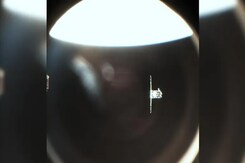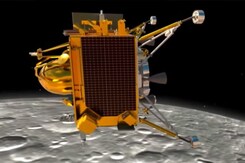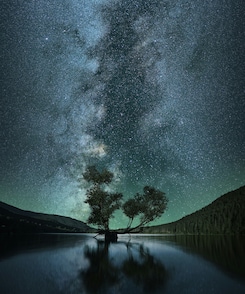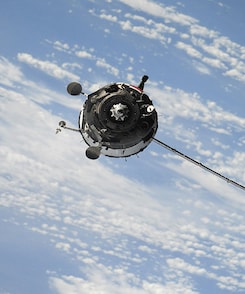Space Scientists
- All
- News
- Videos
- Web Stories
-

Massive Sunspot Complex on the Sun Raises Risk of Strong Solar Storms
- Tuesday December 9, 2025
- Written by Gadgets 360 Staff
A massive sunspot complex has appeared on the Sun, covering an area comparable to the legendary Carrington Event region. Known as AR 4294-96, the active cluster features highly tangled magnetic fields that could unleash powerful solar flares and geomagnetic storms, potentially disrupting satellites, power grids, and global communications if Earth-d...
-
 www.gadgets360.com
www.gadgets360.com
-

Glaciers Speed Up in Summer and Slow in Winter, New Global Map Reveals
- Sunday December 7, 2025
- Written by Gadgets 360 Staff
A new global map of glacier speeds, built from nearly a decade of satellite observations, shows that glaciers consistently move faster in summer and slower in winter. Meltwater acts as a natural lubricant, accelerating flow during warm months. Scientists warn that glaciers with strong seasonal shifts are likely to speed up long-term, adding to futu...
-
 www.gadgets360.com
www.gadgets360.com
-

Strongest Solar Flare of 2025 Sends High-Energy Radiation Rushing Toward Earth
- Saturday December 6, 2025
- Written by Gadgets 360 Staff
A powerful X5.1 solar flare on November 11, 2025, sent high-speed protons toward Earth, producing the strongest radiation spike detected in nearly two decades. The event caused a rare ground-level enhancement, briefly raising radiation at flight altitude to ten times normal. While not dangerous this time, scientists warn larger flares could threate...
-
 www.gadgets360.com
www.gadgets360.com
-

Misaligned Exoplanet Is Challenging How We Think Solar Systems Form
- Friday December 5, 2025
- Written by Gadgets 360 Staff
Astronomers studying the dwarf-star system TOI-3884b have uncovered a striking anomaly: the planet’s orbit is sharply misaligned with its star’s rotation. Using multicolour transit observations, researchers detected repeated starspot-crossing events that revealed the planet passes over cooler regions on the stellar surface. Follow-up monitoring...
-
 www.gadgets360.com
www.gadgets360.com
-

Scientists Inch Closer To Solving Cosmic Dust Mystery On Distant Star
- Wednesday December 3, 2025
- Science | Edited by Srishti Singh Sisodia
The discovery of Kappa Tucanae A's companion star provides a unique "laboratory" for studying hot exozodiacal dust.
-
 www.ndtv.com
www.ndtv.com
-

Scientists Find Clock on Mars Runs 477 Microseconds Faster Than Earth
- Thursday December 4, 2025
- Written by Gadgets 360 Staff
A new study by NIST physicists shows that clocks on Mars run about 477 microseconds faster per day than identical clocks on Earth. The difference comes from Mars’s weaker gravity, orbital eccentricity, and gravitational influences across the solar system. Though tiny, this daily time lead will pose challenges for future Mars navigation and commun...
-
 www.gadgets360.com
www.gadgets360.com
-

New Gravitational-Wave Signal May Reveal Primordial Black Holes Born After the Big Bang
- Monday December 1, 2025
- Written by Gadgets 360 Staff
Scientists have spotted an unusual gravitational-wave signal that may reveal the universe’s first primordial black holes—tiny relics dating back to the Big Bang. Recorded by LIGO–Virgo–KAGRA in November 2025, the event involves an object far lighter than any known stellar remnant. If verified, it could reshape theories of black holes and da...
-
 www.gadgets360.com
www.gadgets360.com
-

New Study Models How Interstellar Objects Could Approach and Impact Earth
- Sunday November 30, 2025
- Written by Gadgets 360 Staff
A new study simulating billions of hypothetical interstellar objects finds that potential Earth-crossing bodies would most likely arrive from the solar apex and the galactic plane. The research highlights relative approach patterns rather than predicting real impacts. Scientists emphasise that known visitors like ‘Oumuamua and Borisov pose no dan...
-
 www.gadgets360.com
www.gadgets360.com
-

Fermi Telescope Detects Gamma-Ray Halo That Could Be First Direct Dark Matter Signal
- Saturday November 29, 2025
- Written by Gadgets 360 Staff
NASA’s Fermi Gamma-ray Space Telescope has detected a faint halo of high-energy gamma rays around the Milky Way’s centre—matching predictions for dark-matter annihilation. The finding, reported by Professor Tomonori Totani, could represent the first direct glimpse of dark matter, but scientists caution that alternative explanations remain and...
-
 www.gadgets360.com
www.gadgets360.com
-

Scientists Finally Identify What Drives Venus’s Fast Winds
- Saturday November 29, 2025
- Written by Gadgets 360 Staff
A new study has identified the primary force behind Venus’s extreme superrotating atmosphere: a once-per-day thermal tide driven by solar heating. Using data from Venus Express and Akatsuki along with circulation models, researchers show that this daily tide transports most of the momentum that accelerates cloud-top winds to speeds over 100 metre...
-
 www.gadgets360.com
www.gadgets360.com
-

PM Modi's Shoutout To Gen Z: "Creativity, Positive Attitude And Ability"
- Thursday November 27, 2025
- India News | Edited by Anwesha Singh
Prime Minister Narendra Modi underscored the critical role of India's Gen-Z in reshaping the country's space sector and said that whenever India opens new opportunities, its young generation, especially Gen-Z, step forward with enthusiasm
-
 www.ndtv.com
www.ndtv.com
-

Dark Matter May Have Been Seen for the First Time in NASA Gamma-Ray Data
- Wednesday November 26, 2025
- Written by Gadgets 360 Staff
A new analysis of NASA’s Fermi telescope data reveals a faint gamma-ray halo around the Milky Way’s core, matching predictions for annihilating dark-matter particles. Researchers say no known astrophysical source fits the signal, raising the possibility of the first direct evidence of dark matter. Experts, however, stress caution and call for v...
-
 www.gadgets360.com
www.gadgets360.com
-

NASA’s Nancy Grace Roman Space Telescope Surpassing Expectations Even Before Launch, Reveals Research
- Tuesday November 25, 2025
- Written by Gadgets 360 Staff
NASA’s upcoming Roman Space Telescope is expected to measure seismic waves in over 300,000 red giant stars, far greater than early predictions. These signals will help scientists better understand exoplanet systems and the Milky Way’s ancient core. Researchers say Roman’s natural survey design enables this breakthrough even before the telesco...
-
 www.gadgets360.com
www.gadgets360.com
-

Mars Orbiter Tracks Interstellar Comet 3I/ATLAS With Unprecedented Precision
- Tuesday November 18, 2025
- Written by Gadgets 360 Staff
Scientists mapped the path of interstellar comet 3I/ATLAS with ten times greater accuracy using images from ESA’s Mars orbiter. The breakthrough shows how observations from different points in space can improve future planetary defense. The data, the first of its kind from another planet’s orbit, offers a powerful new tool for tracking fast-mov...
-
 www.gadgets360.com
www.gadgets360.com
-

Massive Sunspot Complex on the Sun Raises Risk of Strong Solar Storms
- Tuesday December 9, 2025
- Written by Gadgets 360 Staff
A massive sunspot complex has appeared on the Sun, covering an area comparable to the legendary Carrington Event region. Known as AR 4294-96, the active cluster features highly tangled magnetic fields that could unleash powerful solar flares and geomagnetic storms, potentially disrupting satellites, power grids, and global communications if Earth-d...
-
 www.gadgets360.com
www.gadgets360.com
-

Glaciers Speed Up in Summer and Slow in Winter, New Global Map Reveals
- Sunday December 7, 2025
- Written by Gadgets 360 Staff
A new global map of glacier speeds, built from nearly a decade of satellite observations, shows that glaciers consistently move faster in summer and slower in winter. Meltwater acts as a natural lubricant, accelerating flow during warm months. Scientists warn that glaciers with strong seasonal shifts are likely to speed up long-term, adding to futu...
-
 www.gadgets360.com
www.gadgets360.com
-

Strongest Solar Flare of 2025 Sends High-Energy Radiation Rushing Toward Earth
- Saturday December 6, 2025
- Written by Gadgets 360 Staff
A powerful X5.1 solar flare on November 11, 2025, sent high-speed protons toward Earth, producing the strongest radiation spike detected in nearly two decades. The event caused a rare ground-level enhancement, briefly raising radiation at flight altitude to ten times normal. While not dangerous this time, scientists warn larger flares could threate...
-
 www.gadgets360.com
www.gadgets360.com
-

Misaligned Exoplanet Is Challenging How We Think Solar Systems Form
- Friday December 5, 2025
- Written by Gadgets 360 Staff
Astronomers studying the dwarf-star system TOI-3884b have uncovered a striking anomaly: the planet’s orbit is sharply misaligned with its star’s rotation. Using multicolour transit observations, researchers detected repeated starspot-crossing events that revealed the planet passes over cooler regions on the stellar surface. Follow-up monitoring...
-
 www.gadgets360.com
www.gadgets360.com
-

Scientists Inch Closer To Solving Cosmic Dust Mystery On Distant Star
- Wednesday December 3, 2025
- Science | Edited by Srishti Singh Sisodia
The discovery of Kappa Tucanae A's companion star provides a unique "laboratory" for studying hot exozodiacal dust.
-
 www.ndtv.com
www.ndtv.com
-

Scientists Find Clock on Mars Runs 477 Microseconds Faster Than Earth
- Thursday December 4, 2025
- Written by Gadgets 360 Staff
A new study by NIST physicists shows that clocks on Mars run about 477 microseconds faster per day than identical clocks on Earth. The difference comes from Mars’s weaker gravity, orbital eccentricity, and gravitational influences across the solar system. Though tiny, this daily time lead will pose challenges for future Mars navigation and commun...
-
 www.gadgets360.com
www.gadgets360.com
-

New Gravitational-Wave Signal May Reveal Primordial Black Holes Born After the Big Bang
- Monday December 1, 2025
- Written by Gadgets 360 Staff
Scientists have spotted an unusual gravitational-wave signal that may reveal the universe’s first primordial black holes—tiny relics dating back to the Big Bang. Recorded by LIGO–Virgo–KAGRA in November 2025, the event involves an object far lighter than any known stellar remnant. If verified, it could reshape theories of black holes and da...
-
 www.gadgets360.com
www.gadgets360.com
-

New Study Models How Interstellar Objects Could Approach and Impact Earth
- Sunday November 30, 2025
- Written by Gadgets 360 Staff
A new study simulating billions of hypothetical interstellar objects finds that potential Earth-crossing bodies would most likely arrive from the solar apex and the galactic plane. The research highlights relative approach patterns rather than predicting real impacts. Scientists emphasise that known visitors like ‘Oumuamua and Borisov pose no dan...
-
 www.gadgets360.com
www.gadgets360.com
-

Fermi Telescope Detects Gamma-Ray Halo That Could Be First Direct Dark Matter Signal
- Saturday November 29, 2025
- Written by Gadgets 360 Staff
NASA’s Fermi Gamma-ray Space Telescope has detected a faint halo of high-energy gamma rays around the Milky Way’s centre—matching predictions for dark-matter annihilation. The finding, reported by Professor Tomonori Totani, could represent the first direct glimpse of dark matter, but scientists caution that alternative explanations remain and...
-
 www.gadgets360.com
www.gadgets360.com
-

Scientists Finally Identify What Drives Venus’s Fast Winds
- Saturday November 29, 2025
- Written by Gadgets 360 Staff
A new study has identified the primary force behind Venus’s extreme superrotating atmosphere: a once-per-day thermal tide driven by solar heating. Using data from Venus Express and Akatsuki along with circulation models, researchers show that this daily tide transports most of the momentum that accelerates cloud-top winds to speeds over 100 metre...
-
 www.gadgets360.com
www.gadgets360.com
-

PM Modi's Shoutout To Gen Z: "Creativity, Positive Attitude And Ability"
- Thursday November 27, 2025
- India News | Edited by Anwesha Singh
Prime Minister Narendra Modi underscored the critical role of India's Gen-Z in reshaping the country's space sector and said that whenever India opens new opportunities, its young generation, especially Gen-Z, step forward with enthusiasm
-
 www.ndtv.com
www.ndtv.com
-

Dark Matter May Have Been Seen for the First Time in NASA Gamma-Ray Data
- Wednesday November 26, 2025
- Written by Gadgets 360 Staff
A new analysis of NASA’s Fermi telescope data reveals a faint gamma-ray halo around the Milky Way’s core, matching predictions for annihilating dark-matter particles. Researchers say no known astrophysical source fits the signal, raising the possibility of the first direct evidence of dark matter. Experts, however, stress caution and call for v...
-
 www.gadgets360.com
www.gadgets360.com
-

NASA’s Nancy Grace Roman Space Telescope Surpassing Expectations Even Before Launch, Reveals Research
- Tuesday November 25, 2025
- Written by Gadgets 360 Staff
NASA’s upcoming Roman Space Telescope is expected to measure seismic waves in over 300,000 red giant stars, far greater than early predictions. These signals will help scientists better understand exoplanet systems and the Milky Way’s ancient core. Researchers say Roman’s natural survey design enables this breakthrough even before the telesco...
-
 www.gadgets360.com
www.gadgets360.com
-

Mars Orbiter Tracks Interstellar Comet 3I/ATLAS With Unprecedented Precision
- Tuesday November 18, 2025
- Written by Gadgets 360 Staff
Scientists mapped the path of interstellar comet 3I/ATLAS with ten times greater accuracy using images from ESA’s Mars orbiter. The breakthrough shows how observations from different points in space can improve future planetary defense. The data, the first of its kind from another planet’s orbit, offers a powerful new tool for tracking fast-mov...
-
 www.gadgets360.com
www.gadgets360.com



























![Gadgets 360 With Technical Guruji: Did You Know? [April 6, 2024] Gadgets 360 With Technical Guruji: Did You Know? [April 6, 2024]](https://c.ndtvimg.com/2024-02/mpconh58_did-you-know_640x480_10_February_24.jpg?downsize=245:163)





